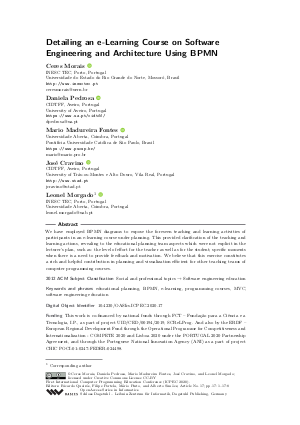Detailing an e-Learning Course on Software Engineering and Architecture Using BPMN
Authors
Ceres Morais  ,
Daniela Pedrosa
,
Daniela Pedrosa  ,
Mario Madureira Fontes
,
Mario Madureira Fontes  ,
José Cravino
,
José Cravino  ,
Leonel Morgado
,
Leonel Morgado 
-
Part of:
Volume:
First International Computer Programming Education Conference (ICPEC 2020)
Part of: Series: Open Access Series in Informatics (OASIcs)
Part of: Conference: International Computer Programming Education Conference (ICPEC) - License:
 Creative Commons Attribution 3.0 Unported license
Creative Commons Attribution 3.0 Unported license
- Publication Date: 2020-06-15
File

PDF
OASIcs.ICPEC.2020.17.pdf
- Filesize: 439 kB
- 8 pages
Document Identifiers
Subject Classification
ACM Subject Classification
- Social and professional topics → Software engineering education
Keywords
- educational planning
- BPMN
- e-learning
- programming courses
- MVC
- software engineering education
Metrics
- Access Statistics
-
Total Accesses (updated on a weekly basis)
0PDF Downloads0Metadata Views
Abstract
We have employed BPMN diagrams to expose the foreseen teaching and learning activities of participants in an e-learning course under planning. This provided clarification of the teaching and learning actions, revealing to the educational planning team aspects which were not explicit in the lecturer’s plan, such as: the level of effort for the teacher as well as for the student; specific moments when there is a need to provide feedback and motivation. We believe that this exercise constitutes a rich and helpful contribution in planning and visualization efficient for other teaching teams of computer programming courses.
Cite As Get BibTex
Ceres Morais, Daniela Pedrosa, Mario Madureira Fontes, José Cravino, and Leonel Morgado. Detailing an e-Learning Course on Software Engineering and Architecture Using BPMN. In First International Computer Programming Education Conference (ICPEC 2020). Open Access Series in Informatics (OASIcs), Volume 81, pp. 17:1-17:8, Schloss Dagstuhl – Leibniz-Zentrum für Informatik (2020)
https://doi.org/10.4230/OASIcs.ICPEC.2020.17
BibTex
@InProceedings{morais_et_al:OASIcs.ICPEC.2020.17,
author = {Morais, Ceres and Pedrosa, Daniela and Fontes, Mario Madureira and Cravino, Jos\'{e} and Morgado, Leonel},
title = {{Detailing an e-Learning Course on Software Engineering and Architecture Using BPMN}},
booktitle = {First International Computer Programming Education Conference (ICPEC 2020)},
pages = {17:1--17:8},
series = {Open Access Series in Informatics (OASIcs)},
ISBN = {978-3-95977-153-5},
ISSN = {2190-6807},
year = {2020},
volume = {81},
editor = {Queir\'{o}s, Ricardo and Portela, Filipe and Pinto, M\'{a}rio and Sim\~{o}es, Alberto},
publisher = {Schloss Dagstuhl -- Leibniz-Zentrum f{\"u}r Informatik},
address = {Dagstuhl, Germany},
URL = {https://drops.dagstuhl.de/entities/document/10.4230/OASIcs.ICPEC.2020.17},
URN = {urn:nbn:de:0030-drops-123045},
doi = {10.4230/OASIcs.ICPEC.2020.17},
annote = {Keywords: educational planning, BPMN, e-learning, programming courses, MVC, software engineering education}
}
Author Details
- INESC TEC, Porto, Portugal
- Universidade do Estado do Rio Grande do Norte, Mossoró, Brasil
- Universidade Aberta, Coimbra, Portugal
- Pontifícia Universidade Católica de São Paulo, Brasil
- CIDTFF, Aveiro, Portugal
- University of Trás-os-Montes e Alto Douro, Vila Real, Portugal
Funding
This work is co-financed by national funds through FCT – Fundação para a Ciência e a Tecnologia, I.P., as part of project UID/CED/00194/2019, SCReLProg. And also by the ERDF – European Regional Development Fund through the Operational Programme for Competitiveness and Internationalization - COMPETE 2020 and Lisboa 2020 under the PORTUGAL 2020 Partnership Agreement, and through the Portuguese National Innovation Agency (ANI) as a part of project CHIC POCI-01-0247-FEDER-024498.
References
- S. Azouzi, Z. Brahmi, and S. Ghannouchi. Customization of multi-tenant learning process as a service with Business Process Feature Model. Procedia Computer Science, 126:606-615, 2018. URL: https://doi.org/10.1016/j.procs.2018.07.295.
- S. Azouzi, S. Ghannouchi, and Z. Brahmi. Modeling of a Collaborative Learning Process with Business Process Model Notation. In Digital Economy. Emerging Technologies and Business Innovation, volume 290, pages 95-104. Springer International Publishing, Cham, 2017. URL: https://doi.org/10.1007/978-3-319-62737-3_8.
- P. Bitzer, M. Söllner, and J. Leimeister. Design Principles for High-Performance Blended Learning Services Delivery: The Case of Software Trainings in Germany. Business & Information Systems Engineering, 58(2):135-149, April 2016. URL: https://doi.org/10.1007/s12599-015-0403-3.
-
S. Brookhart. How to give effective feedback to your students. Association for Supervision and Curriculum Development, Alexandria, Va, 2008.

-
J. Cravino. Planning teacher mediation in science and technology lessons. In J. B. Lopes, J. Cravino, E. de Souza Cruz, and A. Barbot, editors, Teaching science: contributions of research for planning, practice and professional development, University teaching and faculty development, pages 45-59. Nova Science Publishers, New York, 2017.

- N. Faizan, M. Gottlieb, A. Loffler, M. Utesch, and H. Krcmar. State-of-the-Art to Measure the TPACK Level of Trainees in Higher Education to Increase the Learnability of the Train-The-Trainer (TTT) Sessions. In 2019 IEEE Global Engineering Education Conference (EDUCON), pages 384-391, Dubai, United Arab Emirates, April 2019. IEEE. URL: https://doi.org/10.1109/EDUCON.2019.8725056.
- OMG Object Management Group. Business Process Model and Notation (BPMN), Version 2.0. Technical Report formal/2011-01-03, OMG - Object Management Group, January 2011. URL: http://www.omg.org/spec/BPMN/2.0.
- M. Kebritchi, A. Lipschuetz, and L. Santiague. Issues and Challenges for Teaching Successful Online Courses in Higher Education: A Literature Review. Journal of Educational Technology Systems, 46(1):4-29, September 2017. URL: https://doi.org/10.1177/0047239516661713.
-
J. Kettunen. Strategy and Quality Maps in Higher Education. US-China Education Review, 8(2):149-159, 2011.

- D. Pedrosa, J. Cravino, L. Morgado, C. Barreira, R. Nunes, P. Martins, and H. Paredes. Simprogramming : the development of an integrated teaching approach for computer programming in higher education. In INTED2016 Proceedings - 10th International Technology, Education and Development Conference March 7th-9th, 2016 — Valencia, Spain, pages 7162-7172, Valencia, Spain, March 2016. IATED Academy. URL: https://doi.org/10.21125/inted.2016.0699.
- A. Pereira, A. Quintas-Mendes, L. Morgado, L. Amante, and J. Bidarra. Universidade Aberta’s pedagogical model for distance education: a university for the future. Universidade Aberta, Lisbon, Portugal, 2008. URL: http://hdl.handle.net/10400.2/2388.
- M. Pereira. Model for production of teaching material: the use of bpmn notation in distance learning courses. Review of Administration and Innovation - RAI, 8(4):45-66, January 2012. URL: https://doi.org/10.5773/rai.v8i4.898.
- F. Siqueira, G. Barbarán, and J. Becerra. A Software Factory for Education in Software Engineering. In 2008 21st Conference on Software Engineering Education and Training, pages 215-222, Charleston, SC, USA, April 2008. IEEE. URL: https://doi.org/10.1109/CSEET.2008.10.
-
B. Trammell and C. LaForge. Common Challenges for Instructors in Large Online Courses: Strategies to Mitigate Student and Instructor Frustration. Journal of Educators Online, 14(1):10, 2017.

